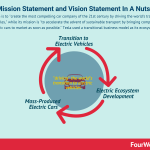Tesla Mission Statement and Vision Statement In A Nutshell

Tesla’s vision is to “create the most compelling car company of the 21st century by driving the world’s transition to electric vehicles,” while its mission is “to accelerate the advent of sustainable transport by bringing compelling mass-market electric cars to market as soon as possible.” Tesla used a transitional business model as its ecosystem grows.
In an official presentation of 2011, Tesla highlighted its vision as:
Create the most compelling car company of the 21st century by driving the world’s transition to electric vehicles
While as highlighted by Elon Musk on Tesla’s blog its mission was:
to accelerate the advent of sustainable transport by bringing compelling mass-market electric cars to market as soon as possible.
To understand what it means we need to look at Tesla’s history, and how it developed.
Tesla was founded in 2003 by a group of engineers. The central idea was to prove that electric cars could be as good, if not better than gasoline alternatives.
As Elon Musk took over as a CEO, he started to roll out a strategy where Tesla could have an entry price competitive with other cars in the market. That is why the first car Tesla launched was a sport’s car, as its pricing was in line with the market.
Indeed, as highlighted by Elon Musk, back in 2013:
Our first product was going to be expensive no matter what it looked like, so we decided to build a sports car, as that seemed like it had the best chance of being competitive with its gasoline alternatives.
Therefore, as go-to-market and entry strategy Tesla used a higher-priced segment of the market, in seemingly sharp contrast with its mission. Yet his was a transitional business model that enabled Tesla to be viable in the short-term and yet achieve its mission in the long-run.
That’s because, in order to become fully viable as a business model, Tesla needed to create an entire ecosystem, also made of energy solutions that could enable electric cars to become competitive in terms of convenience (meant as the ability to charge anywhere) in respect to gasoline vehicles.
Therefore, as Tesla rolls out its business model, by enabling this ecosystem to grow, year over year, the company can enter larger and larger segments of the markets by offering lower-priced options, that might make it possible for Tesla’s vehicles to achieve mass adoption.
[image error]
Read next: Tesla Business Model, Tesla SWOT Analysis
Other resources:
53 Successful Types of Business Models You Need to KnowThe Complete Guide To Business DevelopmentBusiness Strategy: Definition, Examples, And Case StudiesBlitzscaling Business Model Innovation Canvas In A NutshellWhat Is Market Segmentation? the Ultimate Guide to Market SegmentationMarketing Strategy: Definition, Types, And ExamplesMarketing vs. Sales: How to Use Sales Processes to Grow Your BusinessHow To Write A Mission Statement
References:
Tesla About PageTesla BlogTesla Earnings Release 2011
The post Tesla Mission Statement and Vision Statement In A Nutshell appeared first on FourWeekMBA.



